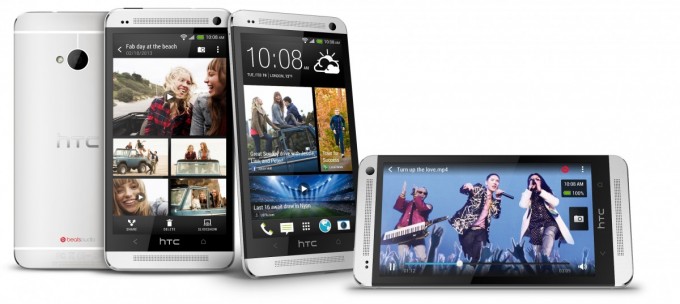
Last night we live-blogged the official announcement by HTC of its 2013 flagship Android smartphone – the (somewhat unimaginatively named) HTC One.
Up until now, the One was going by its codename the M7, and you can read the evolution of the M7 / HTC One here. Here, we’ll give you a summary of what the HTC One offers, and the low-down on the HTC One’s specs.
So, what’s the HTC One?
From last year, which saw a multitude of phones named HTC One (insert something here), including the One X, One SV, One XL, One S and so on, we now have one HTC One, rocking a 4.7 inch Super LCD 3 display, powered by a Qualcomm Snapdragon 600 and Adreno 320 GPU. This is one little powerhouse — it should show a 40% power increase over 2012’s range.
All this sits inside a single block of aluminium, furthering the industrial design quality that HTC is known for.
Powering this is the 2,300 mAh battery — this is a good amount of juice, and time will tell whether it’s enough to make this an all day phone, or a half-day wonder. We’re a little disappointed that HTC have continued to go for capacitive buttons — but only two, one for Back on the left, and one for Home on the right. A double tap on home will show the multi-tasker, and a long press will activate Google Now.
Software wise, we can expect Android 4.1.2 Jelly Bean (though in a quick browse of the news, I can’t see any mention of an update to 4.2) and HTC Sense 5. While Sense is similar to its previous incarnations, it’s more in keeping with the Android design guidelines, using the Roboto font and generally being more consistent with the Android look and feel. While I’ve not personally used it yet, the descriptions suggest that Sense is now a lot less prescriptive, and offers more options and customisations to make your phone truly your own.
The camera is one feature that is a mixed bag — it’s only an effective 4.0 megapixel shooter, whereas many smartphones are rocking megapixel values double or triple this.
However, the individual sensor elements are 2.0 microns wide, instead of 1.4 microns for 2012’s HTC cameras. This means that you’ll see better low-light performance, and brighter, perhaps more life-like photos to boot.
Not to mention, megapixels truly aren’t everything, and a lower megapixel count does not mean a worse image, especially when paired with high quality optics and a good image processor behind it, both of which it seems the HTC One will offer.
This is just a quick preview based on what we’ve seen — our very own Jason Murray and Graham Bae will be attending HTC’s Australian launch event tomorrow night in Sydney, and will bring you more once they’ve had an official introduction.
On with the specs rundown!
Key specs
- Android 4.1.2 with HTC Sense 5
- Processor: Qualcomm® Snapdragon™ 600, quad-core, 1.7GHz
- Total storage: 32GB/64GB
- RAM: 2GB
- Battery: 2300 mAh embedded rechargeable Li-polymer battery
Camera
- BSI sensor, Pixel size 2.0 μm, Sensor size 1/3′
- Dedicated HTC ImageChip™ 2
- 28mm F/2.0 lens (in other words, a nice bright wide angle lens)
- Optical Image Stabilization (OIS)
- Smart Flash: Five levels of flash automatically set by distance to subject
- Front Camera: 88 wide angle lens with HDR capability
- 1080p Full HD video recording for both front and back cameras
- HDR Video
- Continuous shooting and VideoPic
- Slow motion video recording with variable speed playback
- HTC Zoe™ with highlights and HTC Zoe™ Share
- Retouch with Object Removal, Always Smile, and Sequence Shot
Connectivity
- 3.5 mm stereo audio jack
- NFC capable
- Compliant with Bluetooth 4.0
- Bluetooth 4.0 with aptX™ enabled
- Wi-Fi®: IEEE 802.11 a/ac/b/g/n
- DLNA® for wirelessly streaming media from the phone to a compatible TV or computer
- Support consumer infrared remote control
- micro-USB 2.0 (5-pin) port with mobile high-definition video link (MHL) for USB or HDMI connection (Special cable required for HDMI connection.)
HTC BOOMSOUND™
- Dual frontal stereo speakers with built-in amplifiers
- Studio-quality sound with Beats Audio™
- HDR Microphone
- Sense Voice
Networking
- GSM/GPRS/EDGE (850/900/1800/1900 MHz)
- WCDMA (1900/2100 (B2/B1) MHz)
- CDMA (800/1900 BC0/BC1/BC10, Sprint)
- LTE (1900 (B25, SPCS)
- Frequencies will vary by region/operator
Sensors
- Gyro sensor
- Accelerometer
- Proximity sensor
- Ambient light sensor
Location and GPS
- Internal GPS antenna + GLONASS
- Digital compass




